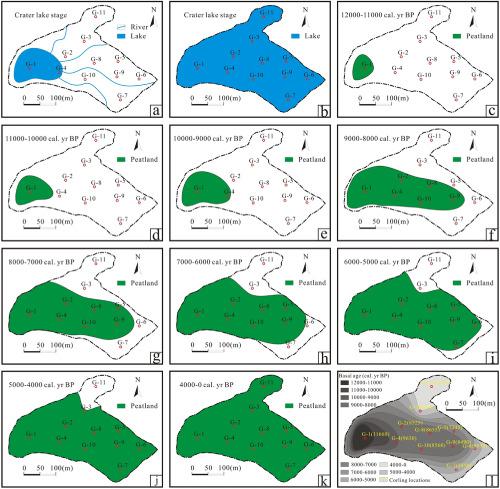当前位置:
X-MOL 学术
›
Earth Surf.Process. Land.
›
论文详情
Our official English website, www.x-mol.net, welcomes your feedback! (Note: you will need to create a separate account there.)
Lake–mire ecosystem transformation and its possible forcing mechanisms in volcanic landform regions: a case study in the Gushantun peatland of northeast China
Earth Surface Processes and Landforms ( IF 3.3 ) Pub Date : 2020-07-16 , DOI: 10.1002/esp.4956 Mingming Zhang 1, 2, 3 , Zhaojun Bu 1, 2, 3 , Shasha Liu 1, 2, 3 , Jie Chen 1 , Yaxin Cui 1 , Xu Chen 1
Earth Surface Processes and Landforms ( IF 3.3 ) Pub Date : 2020-07-16 , DOI: 10.1002/esp.4956 Mingming Zhang 1, 2, 3 , Zhaojun Bu 1, 2, 3 , Shasha Liu 1, 2, 3 , Jie Chen 1 , Yaxin Cui 1 , Xu Chen 1
Affiliation

|
Large numbers of peatlands were developed in volcanic landform regions, which would provide valuable long‐term records of lake–mire ecosystem shifts and act as significant carbon pool in regional carbon cycle. To investigate lake–mire ecosystem transformations and driving mechanisms in volcanic landform regions, the developmental history of Gushantun peatland in northeast China was reconstructed in this study. Results indicate that Gushantun peatland initiated in the deepest portions of the basin, and subsequently experienced expansions outward. Peat initiated from approximately 12 ka cal. bp to present. The developmental patterns of Gushantun peatland can be divided into four stages: the stable stage 1 (12–10 ka cal. bp), maximum stage (10–7 ka cal. bp), stable stage 2 (7–4 ka cal. bp) and stable stage 3 (4–0 ka cal. bp). The possible forcing mechanisms for the development of Gushantun peatland were different during different periods. From 12 ka cal. bp to 10 ka cal. bp, autogenic process was probably the major controlling factor for the expansion of this peatland. From 10 to 7 ka cal. bp, flat basin morphology was the major influence factor for fast expansion. However, the development of Gushantun peatland was probably controlled by the dual effects of high moisture and autogenic process during the period of 7 to 4 ka cal. bp. From 4 ka cal. bp to present, steep basin morphology was the major influence factor, while moisture might be the secondary factor for development of Gushantun peatland. These features indicate that lake–mire ecosystem transforms in volcanic landform regions of Changbai Mountains were probably triggered by the complex effects of autogenic process, hydroclimate and underlying basin morphology. © 2020 John Wiley & Sons, Ltd.
更新日期:2020-07-16



























 京公网安备 11010802027423号
京公网安备 11010802027423号